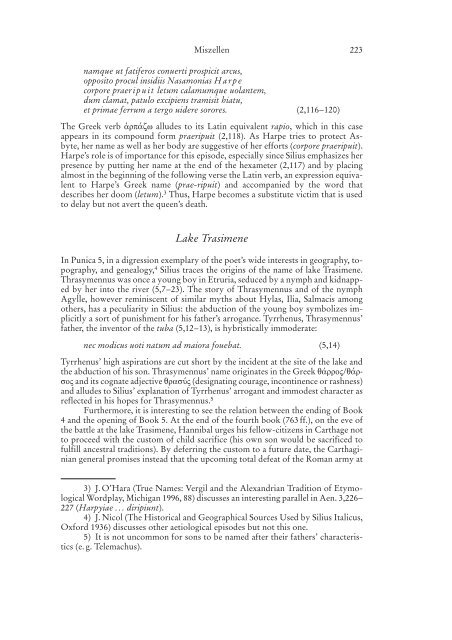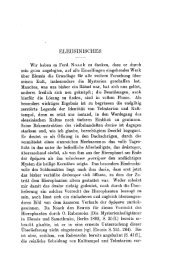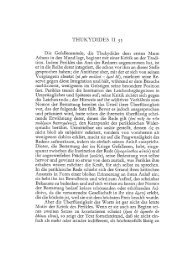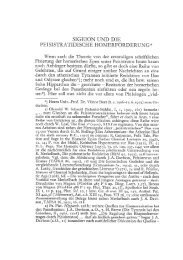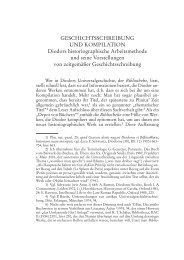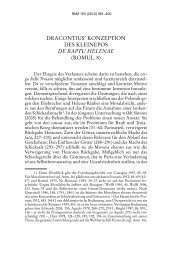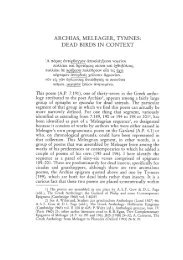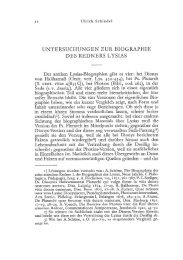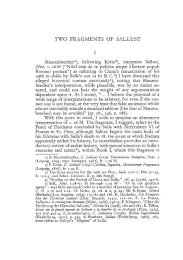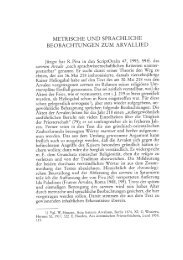VIRGILIO E STESICORO Una ricerca sulla Tabula Iliaca Capitolina *
VIRGILIO E STESICORO Una ricerca sulla Tabula Iliaca Capitolina *
VIRGILIO E STESICORO Una ricerca sulla Tabula Iliaca Capitolina *
Erfolgreiche ePaper selbst erstellen
Machen Sie aus Ihren PDF Publikationen ein blätterbares Flipbook mit unserer einzigartigen Google optimierten e-Paper Software.
Miszellen<br />
223<br />
namque ut fatiferos conuerti prospicit arcus,<br />
opposito procul insidiis Nasamonias Harpe<br />
corpore praeripuit letum calamumque uolantem,<br />
dum clamat, patulo excipiens tramisit hiatu,<br />
et primae ferrum a tergo uidere sorores. (2,116–120)<br />
The Greek verb èrpãzv alludes to its Latin equivalent rapio, which in this case<br />
appears in its compound form praeripuit (2,118). As Harpe tries to protect Asbyte,<br />
her name as well as her body are suggestive of her efforts (corpore praeripuit).<br />
Harpe’s role is of importance for this episode, especially since Silius emphasizes her<br />
presence by putting her name at the end of the hexameter (2,117) and by placing<br />
almost in the beginning of the following verse the Latin verb, an expression equivalent<br />
to Harpe’s Greek name (prae-ripuit) and accompanied by the word that<br />
describes her doom (letum). 3 Thus, Harpe becomes a substitute victim that is used<br />
to delay but not avert the queen’s death.<br />
Lake Trasimene<br />
In Punica 5, in a digression exemplary of the poet’s wide interests in geography, topography,<br />
and genealogy, 4 Silius traces the origins of the name of lake Trasimene.<br />
Thrasymennus was once a young boy in Etruria, seduced by a nymph and kidnapped<br />
by her into the river (5,7–23). The story of Thrasymennus and of the nymph<br />
Agylle, however reminiscent of similar myths about Hylas, Ilia, Salmacis among<br />
others, has a peculiarity in Silius: the abduction of the young boy symbolizes implicitly<br />
a sort of punishment for his father’s arrogance. Tyrrhenus, Thrasymennus’<br />
father, the inventor of the tuba (5,12–13), is hybristically immoderate:<br />
nec modicus uoti natum ad maiora fouebat. (5,14)<br />
Tyrrhenus’ high aspirations are cut short by the incident at the site of the lake and<br />
the abduction of his son. Thrasymennus’ name originates in the Greek yãrrow/yãrsow<br />
and its cognate adjective yrasÊw (designating courage, incontinence or rashness)<br />
and alludes to Silius’ explanation of Tyrrhenus’ arrogant and immodest character as<br />
reflected in his hopes for Thrasymennus. 5<br />
Furthermore, it is interesting to see the relation between the ending of Book<br />
4 and the opening of Book 5. At the end of the fourth book (763 ff.), on the eve of<br />
the battle at the lake Trasimene, Hannibal urges his fellow-citizens in Carthage not<br />
to proceed with the custom of child sacrifice (his own son would be sacrificed to<br />
fulfill ancestral traditions). By deferring the custom to a future date, the Carthaginian<br />
general promises instead that the upcoming total defeat of the Roman army at<br />
3) J. O’Hara (True Names: Vergil and the Alexandrian Tradition of Etymological<br />
Wordplay, Michigan 1996, 88) discusses an interesting parallel in Aen. 3,226–<br />
227 (Harpyiae . . . diripiunt).<br />
4) J. Nicol (The Historical and Geographical Sources Used by Silius Italicus,<br />
Oxford 1936) discusses other aetiological episodes but not this one.<br />
5) It is not uncommon for sons to be named after their fathers’ characteristics<br />
(e. g. Telemachus).


